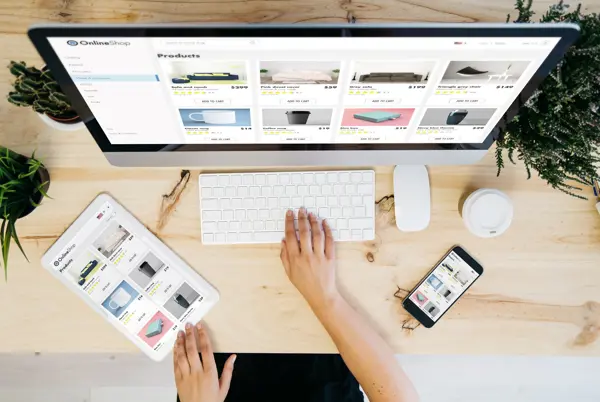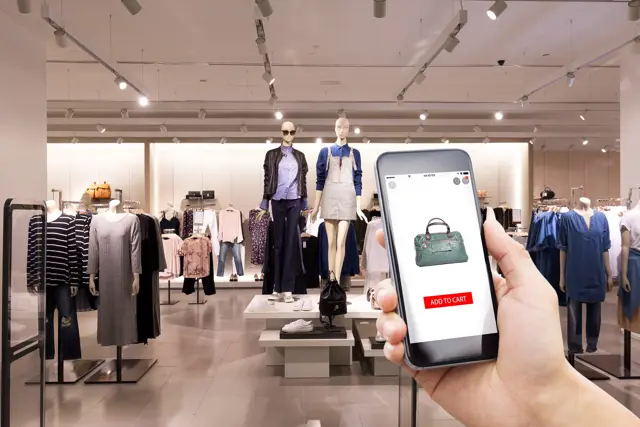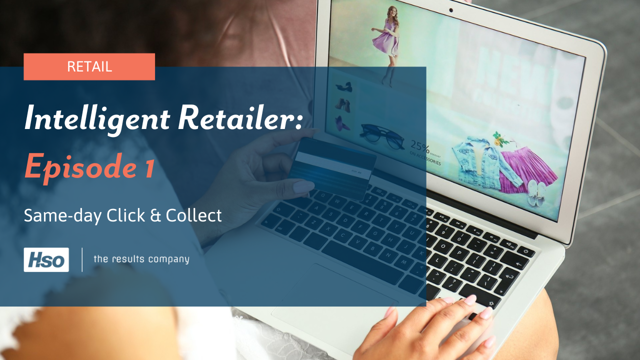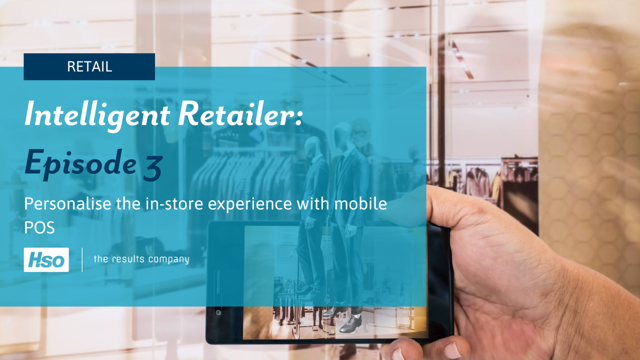Get more Retail Sector insight from HSO
Dynamics Matters Podcast: Episode 4 - Multi-Channel Retailing
With special guest Colm McArdle, Microsoft’s retail technology expert.
✔ Multi-channel experience remains essential
✔ Why the Pandemic has been perhaps the most painful social retail study on the planet.
✔ Learn what Colin calls the non-creepy type omni channel.
Podcast summary:
Multi-Channel Retailing
Welcome to you, our lovely listeners to the HSO dynamics matters podcast, your regular Sonic dive into the world of Microsoft technology-related matters and much more Besides. I’m Michael Lonnon and today I’m joined by Microsoft’s retail technology expert, Colm McArdle.
In this edition, we talk about multichannel retailing, why some are doing it well, and why it remains a challenge for so many others. We also discovered that Colin owned a pair of high-tech boots, which I did too. I guess that makes me older than I’d like to think. Although you can still get them. Anyway, I digress. Grab a brew, sit back, relax, and enjoy the show.

Transcript
MICHAEL LONNON: Tea or coffee?
COLM MCARDLE: Coffee.
MICHAEL LONNON: How do you have it?
COLM MCARDLE: Small dash of milk and two sugars.
MICHAEL LONNON: Very refined, very refined.
COLM MCARDLE: Depends on the size of the cup, might I add.
MICHAEL LONNON: How big is the one in the morning? Is it larger than the one in the afternoon?
COLM MCARDLE: It’s the biggest in fact I only have two cups of coffee. I have one in the morning and one after half past nine. And then that’s it.
MICHAEL LONNON: Very restrained. Sand or snow?
COLM MCARDLE: Snow.
MICHAEL LONNON: Okay, high tech or low tech.
COLM MCARDLE: I used to have high tech boots back in the day. Remember them?
MICHAEL LONNON: I do, you’re making me show my age now. Okay, that’s unfortunate. Shop in store or buy online?
COLM MCARDLE: Shop in store for clothes, shop online for everything else.
Same-day Click & Collect
Discover existing capabilities and recent product enhancements that help retailers facilitate a comprehensive Buy-Online, pick-up In-Store order processing flow with Dynamics 365 Commerce.
MICHAEL LONNON: Do you like the physical experience? I quite like going into a shop and handling things.
COLM MCARDLE: I very much like it. I was in a shop on Sunday, my favourite little shop of all time, for the first time in like 15 months. And I didn’t buy anything online from them, even though I really tried hard to. They do a bunch of different brands. And it’s very difficult to know what fits, you have to try over 10 things to get the right fit.
MICHAEL LONNON: I do hate that actually, I do order some stuff in and you find it doesn’t quite fit as you hoped it would, it’s not quite the same as going to the shop and trying on, is it? Anyway, we digress. When it comes to that kind of shopping experience for retailers, they’re trying to create this multi-channel experience or this omni-channel experience where everything’s kind of connected, and it feels like the same experience for a customer. But what’s the challenge in delivering that or creating that experience for retailers do you think?
COLM MCARDLE: Because everything keeps changing for all retailers. Whether they’re essential or non-essential they have been trying to do this anyway, for years. But I think what’s happened, and we don’t want to overplay what’s happened in the last year, but the freight train, that is COVID-19 has smashed it through the middle with any business plans or any future plans that any organisations have had, on how to actually approach this multi-channel and it’s changed even consumer behaviours as well.
This has made it really, really difficult because, it’s a small point that I used a minute ago, and I don’t want to talk fashion on apparel too much but that’s probably the closest of my own experience. I really want to do the online thing but I’m not getting the same experience. And I know retailers of all kinds struggle with that. It’s when they’re used to one channel or maybe two channels but when they start to try and go into different channels, it’s trying to maintain that consistency of the experience that they’re trying to give to the customers. That’s what’s made them successful in the past. It’s really that.

Deliver omni-channel excellence with Microsoft Dynamics 365 Commerce
For retailers, delivering a seamless and engaging omni-channel shopping experience matters now more than ever. Empowered by technology and spoilt for choice when it comes to making purchase decisions, today’s consumers are in full control of how, where, and when they shop.

MICHAEL LONNON: Do you think it’s a learning thing? Do you think like you just said there, where a retailer has grown up on one particular platform doing it well, now they’re like, oh crikey, we’ve got to catch up and do this and not quite getting it right. Is it kind of a bit like that?
COLM MCARDLE: I mean, potentially. Disruption in all industries has been happening for years. I mean, just look at technology. Uber has completely rewritten that entire industry so has, Airbnb so has Facebook, they’ve all done it. But I think the biggest disrupter of the retail has been COVID-19. And the ability for organisations to adapt and pivot really quickly. If you look at the brands, like the Blues for it is a good example or even ASOS, these guys popped up 15, 20 years ago, and they were just another company that did something different to what most of the population were used to i.e. the high street.
But then they were just using a different channel and other organisations didn’t think they had to adapt. But actually, if you look down at the last year, they’ve actually grown their business model and it has really stood the test of time. It really took the disruption of last year even though they are non-essential retail, they actually grew their businesses, because they were able to continue on untouched. Because they nailed it, they pretty much nailed that model. But what they don’t have, is then the ability to revert back to, the bricks and mortar, where a lot of the online stores were headed anyway.
MICHAEL LONNON: With companies of a retail sort of focus. Do you think the change of COVID, the tipping point of COVID? Do you think the changes that these companies are putting in place are permanent? Do you think COVID has been a tipping point to permanent change?
COLM MCARDLE: To a permanent kind of change? Definitely. I don’t think that the online model is the only way forward. Definitely not. 12 is a lifetime for that industry. But that business model took that disruption straight on the chin, and it didn’t actually impact it on some of the more mature brands, more the high street brands, you know, the Debenhams and even the Arcadias, these were the organisations that came in and scooped those brands out.
But what has also happened is that things have changed, within the last 12 months people have really created new trends, and disruption has definitely accelerated. And even people will argue that whatever retailers decide to do in the next 12, or even three to six months, could actually impact how they turn out in five years, business models have to change for sure. But new partnerships are having to be established as well, because of the impact of the supply chain. And again, back to the multi-channel that you referenced, and then customer expectations. This is very sort of myopic view. But from my own personal opinion, I’m super comfortable online or I’ll do online a lot now, but I don’t want to do clothes online.
Video: Personalise the in-store experience with mobile POS
Microsoft Dynamics 365 Store Commerce Mobile App enables retail businesses to manage back-office operations, customer loyalty and process in-store transactions.
MICHAEL LONNON: Certain things you’ll do, certain things you don’t want to do.
COLM MCARDLE: And even I’ll sort of finish this out, another thing that was picked up as well. And this has definitely been highlighted it in the last year is the cost of actually doing business. Because it’s well documented in public records, the margins and profits in retail have plummeted. And there is an increasing pressure on margins anyway. But what’s happened now as well, is that in the last 12 months, and anybody thinking about business models, it’s there’s all these new costs popping up along their value chain, and costs that they may or may not have been expecting, but anything that they do do moving forward needs to embrace that or needs to actually put a proper plan in place. So, they can start to remove cost by them doing their business.
MICHAEL LONNON: Where does technology fit in all this then? So from a multi-channel perspective from support in the business of making sure like you said then, what they’re doing now or in the next three to six months will actually impact them in five years’ time. Where does technology fit in this? and how valuable is it to get that kind of foundation of technology, right? In order to then sort of protect yourself, protect yourself probably isn’t the right word, but to grow the business?
COLM MCARDLE: Obviously, we’re guilty, collectively guilty because we’re technology organisations, but at the heart of everything we do, we help customers solve problems. And you’re right, technology will help and will absolutely be the platform upon which these organisations will move forward on. But one thing that we’re always very conscious, and certainly at Microsoft, is not jumping into solve the problem, before we actually understand the problem, as different retailers are at different stages of their collective lives and across, we work with a lot of essential, non-essential time organisations, but at a very high level, the way we look at it from a business applications perspective, but certainly, organisations must have and we will preach this a lot. And we’re convinced by it, I mean, if it stacks up in every situation where customers must have a strategy, or at least a path towards connecting the customer interactions with the product interactions with the employee interactions on the operations. And at the heart of that is data. So, capturing all of the telemetries that’s occurring between the customer and between the product, the operations and so on, all with the view, to driving a much deeper relationship with the customer, all with the view of empowering the employee to be more productive, let’s say, or more relevant at the right time to the customer, and ensuring you’re getting the right product out, and ensuring that you’re doing it efficiently. But this doesn’t happen with our data.
At the heart of everything that we’re seeing is data and certainly moving forward, then what we see is data needs to be there as it’s a data-driven approach. With the connected processes. I heard a well-established UK retailer, talk about the CEO, we were on an internal call and he pulled us away, he said, “You know what, we are data billionaires, got all this data, but we’re information bankrupt”, simply cannot make sense of it but I thought that was really proven because organisations will have this but in desperate parts, but it’s taking it together and connecting it and making sense of it across those four facets that I just mentioned. And that’s effectively the start of any organisation's journey into any kind of transformation or digital transformation.
But another, certainly from a Microsoft perspective, what we’re doing and certainly how we’re architecting our solutions, and I don’t want to get into too much detail on it but from a retail perspective, we want it at a very high level to ensure that organisations, whatever strategies that they put in place, whatever investments are making in technologies ensuring that that they can connect the digital/online experience, which is a journey and with the human assistant, that used to be the de facto go to the shop, but actually now there’s a term for the human-assisted experience. But it’s getting those two completely immersed, in other words, omni-channel – I know that omni channel has been around since God was a boy, but now it’s become more relevant than ever, even I’m buying into it now. I mean, come on guys, this has to be right. You have to get the right that sort of level of personalisation, not the creepy type but the type that you understand me Mr Retailer, you know what I’m after.
Dynamics 365 OmniChannel Solution
Omnichannel from HSO provides live chat capabilities that will help resolve your customer's issues online.
Omnichannel for Customer Service offers a suite of capabilities that extend the power of Dynamics 365 to enable organizations to instantly connect and engage with their customers across digital messaging channels.
HSO built a centralized solution that provides real time personalized support and will help your business optimize operational costs. With the Dynamics 365 OmniChannel solution your business will be able to deliver 24x7 automated customer support, save customer service costs and improve user experience.

MICHAEL LONNON: What’s revealing from this chat with Colin, is the delivery of a good multi-channel experience remains essential. Because people’s preferences and how they engage is often unpredictable. It could be one way or another. And what I mean by this is that the pandemic has forced the retailer to work on delivering a better digital experience. And yet, as the shops have opened, many people are enjoying the experience of touching and trying products in a store environment, oddly this pandemic has been perhaps the biggest, most painful social retail study on the planet.
The task remains to ensure both the online and in-store experience is positive and that retailers are catering for each customer’s own unique shopping preference. To learn what Colin calls the non-creepy type omni channel. I also learned that buying in the shop is also known as human-assisted experience which is a new phrase to me. And on that note, take care of yourselves.



